How to Make Butter from Raw Milk In a Blender
When it comes to the amazing benefits that a family milk cow provides, raw milk butter may be at the top of that list! Making butter may bring up mental images of Ma Ingalls churning her butter. However, we will show you the quick and easy way how to make butter from raw milk in a blender.

It is no secret that we are big fans of owning a family milk cow. She allows us to weekly make yogurt, ice cream, butter, cheese, and a host of other delicious and nutritious foods and drinks. I honestly had never made butter before until we got Thimble, our milk cow. We were inundated with more cream than we knew what to do with! After the first time making this creamy, golden yellow butter, there was no going back.
Nutritional Benefits of Butter
It is hard to believe the demonization that butter has endured over the years. Worse yet, synthetic margarine was long touted as a superior replacement. Butter, when coming from healthy cows raised on fresh green pasture is a nutritional powerhouse second to none.
In fact, adding quality butter to the diet has been found to be protective against heart disease, cancer, arthritis, and osteoporosis. Butter has also been found to strengthen the immune system, thyroid, gastrointestinal system, and be a crucial factor in robust growth and development, especially in children.
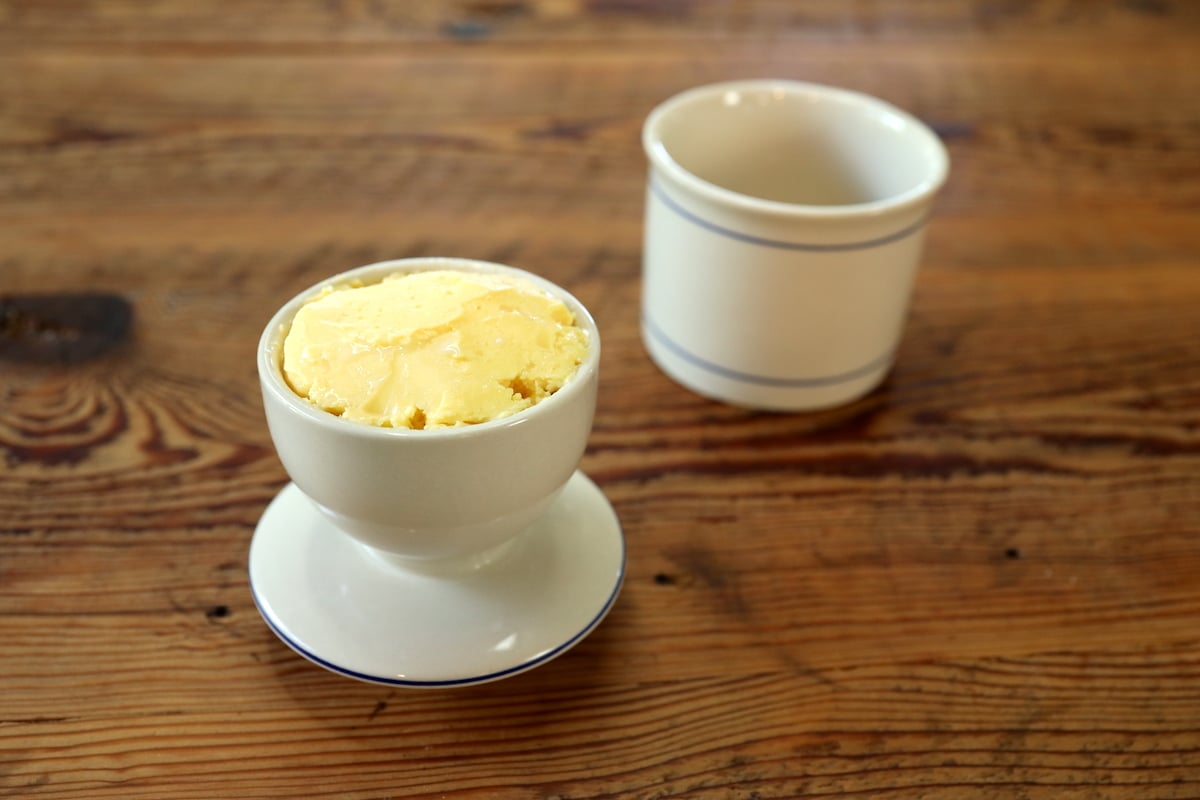
One of the biggest contributing factors in butter to make it invaluable to health is its readily available form of vitamin A. Unless someone is regularly consuming organ meats (which we strongly encourage), Vitamin A can be extremely difficult to get in the modern diet. Vitamin A is an antioxidant and is involved in so many important body functions. Deficiency in Vitamin A results in a host of health deficiencies many of which are becoming more and more common.
Additionally, butter is a great source of vitamin E, K2, and Selenium. These all have important antioxidant and health promoting functions. For more information on the specifics of butter and the role it plays in robust health, check out this article by the Weston A. Price Foundation.
The History of Butter
Butter has been a staple for cultures around the globe for thousands of years. The oldest records document butter being made by filling an animal skin sack with milk (primarily from goats because cows were not yet domesticated). They would rock the sack back and forth until eventually butter was made. Nomadic groups would hang the sack off of the side of a pack and the butter would simply form over time through the process of walking.
Over time, equipment was developed and various butter churns became the common method of making butter for centuries. Spanning the Middle Ages through the Industrial Revolution, butter churns were the most used device for butter making.
Making butter was an essential activity in most households. Women would spend hours churning butter and storing for their family and often selling, sharing, or bartering with neighbors. Eventually, butter moved from an at home process to a commercial and industrial one to meet the needs of larger urban populations.
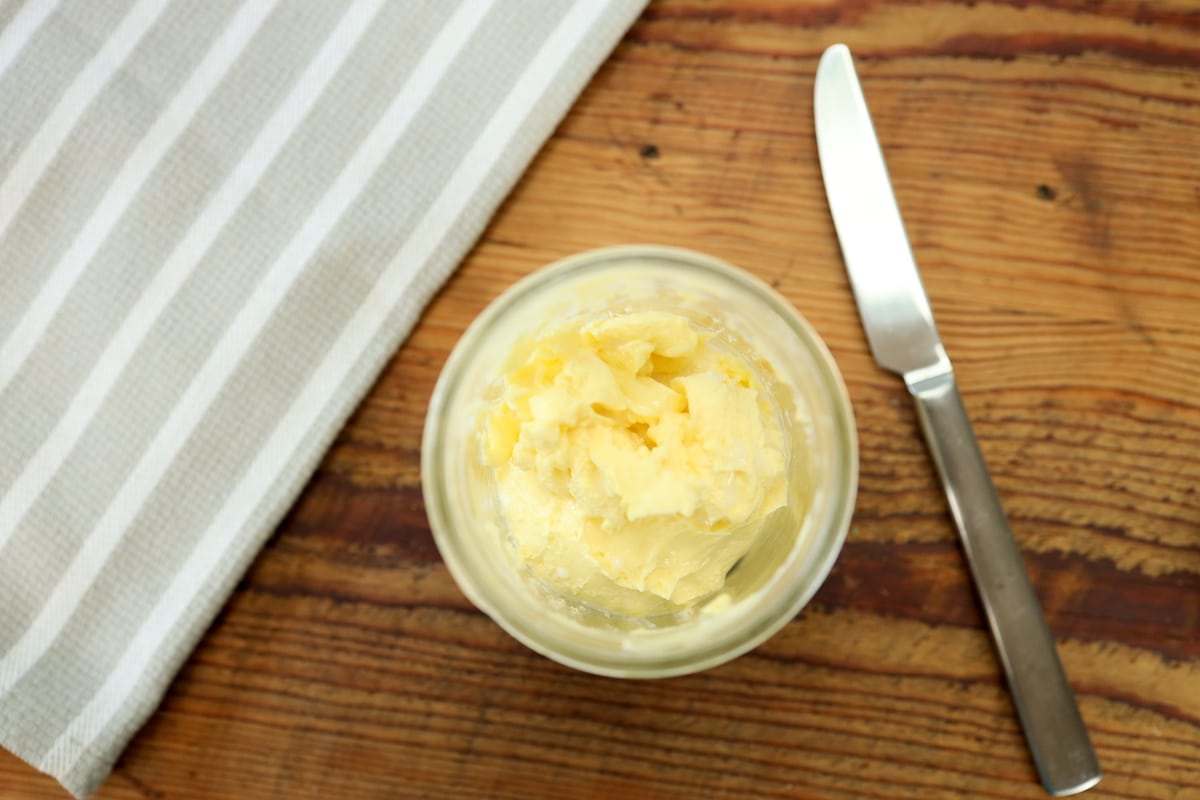
Butter Making Options
As indicated above, there are a lot of ways to make butter. Anyway you can agitate heavy cream enough to separate the butter fat from the buttermilk will work. Shake it like the dickens, churn it, or use a more modern method.
The most common ways to make butter in our modern world of fancy appliances is with either a stand mixer, food processor, or blender. When it comes to making butter in a blender, we love the versatility of our Vitamix. It’s helpful if your equipment can adjust the speed it churns from high to lower as your cream turns to whipped cream and finally separates into butter.
Tips For Successful Butter Making
In our experience, there have been a couple key things that have made a big difference in butter making.
- Pull your cream out of the fridge 2-3 hours before you want to make butter. Room temperature cream turns much more easily into butter than cold cream.
- Wait until your cream is at least 2-3 days old before making butter. Sometimes if your butter is super fresh, it will be more challenging to turn it into butter. We like to wait at least 24 hours after milking to skim the cream anyway to make sure it is fully separated.
- Cows on fresh grass make much better butter than cows on hay. This is one I had no idea about until we started making butter regularly. The texture of the butter when cows are on fresh green pasture is smooth, soft and creamy. You can still totally make butter if your cows are eating hay but the texture will likely be more crumbly and less creamy.
Fresh vs. Cultured Butter
As it sounds, cultured butter is just that – it has been inoculated with a culture to get the added benefits of the beneficial bacteria (think yogurt) and will have a tangier taste. When using fresh raw cream, it is easy to make either option.
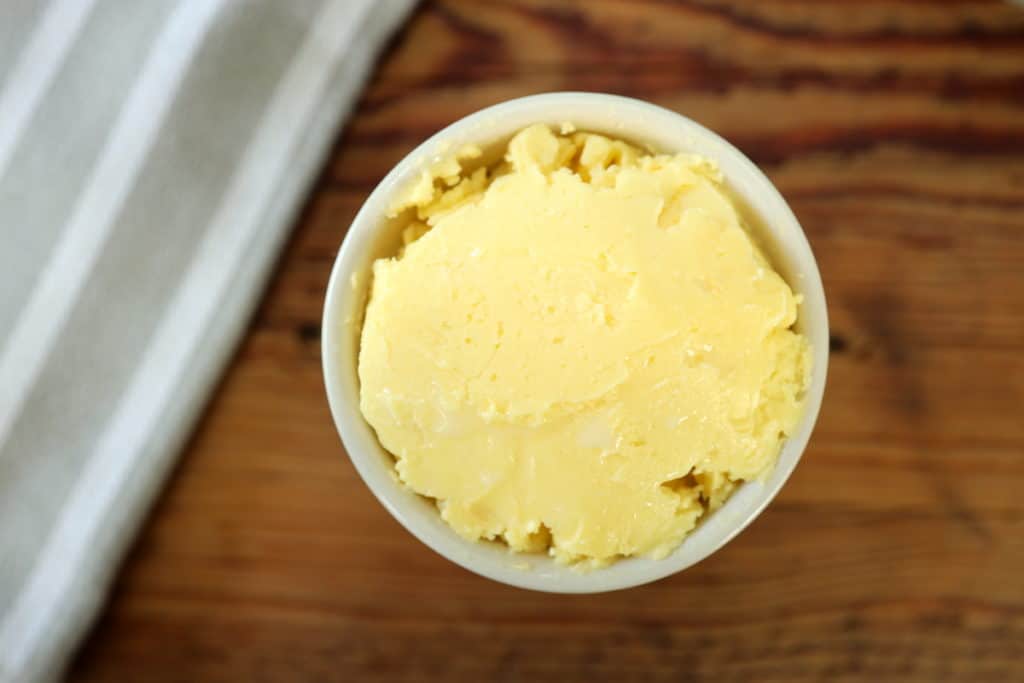
Fresh cream is simply made by taking your cream, a few days old, turning it into butter and consuming it pretty quickly. Because this milk is unpasteurized, it will still have all of those beneficial enzymes and microbes. Overtime, even if making fresh butter, the butter will become cultured. There is nothing wrong with it and it’s still great for eating as it now has the added benefits of more of those beneficial bacteria.
If you would like to speed up the process of making cultured butter, you can ferment your cream on the counter for 24 or so hours until it develops more of a soured taste and then make your butter from there.
Can You Use Store Bought Milk to Make Your Own Butter?
Absolutely! If you don’t have access to fresh raw milk, no problem. You can just use store bought heavy cream and follow the same instructions below.
How to Make Raw Milk Butter in a Blender
Ingredients:
– 1 pint heavy cream (or more!)
– Salt or other herbs (optional)
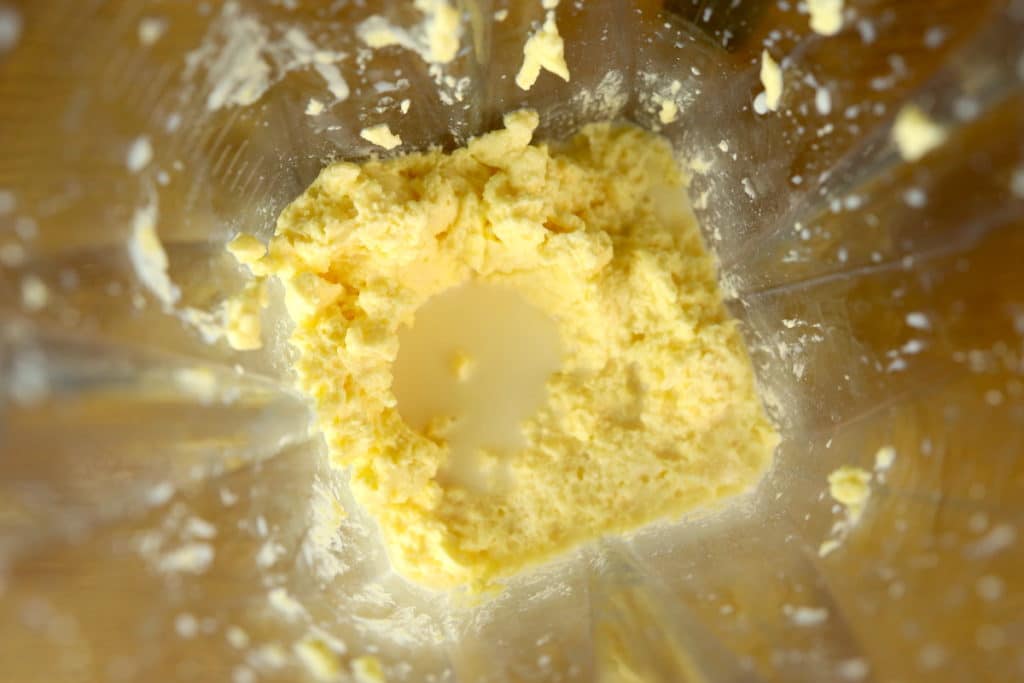
Directions:
- Remove cream from the fridge 2-3 hours before you want to make your butter.
- Pour cream into a blender.
- Turn to a medium to high speed (6-7 on Vitamix) and watch as your cream begins to thicken to a whipped cream.
- Once a whipped cream is made, reduce speed to low to medium (2-4 on Vitamix).
- Mix on low speed until the whipped cream breaks and the butter fat has separated from buttermilk. I like to use the tamper that comes with the Vitamix to agitate the cream during this step.
- Once cream has fully separated out the fat globules from the buttermilk, turn off the blender.
- Pour the contents of your blender into a fine mesh strainer catching the butter in your strainer and collect your buttermilk in another container below.
- When you have all of your butter in the strainer, you want to remove as much of the remaining buttermilk as possible. Do this by cooling the butter down right away. You could submerge you butter in an ice bath but I prefer to form it into a ball and run it until cold tap water. Gently squeeze any remaining buttermilk out.
- Optional – mix in salt or herbs as desired.
- Put the butter into a container of choice and refrigerate until ready to use.
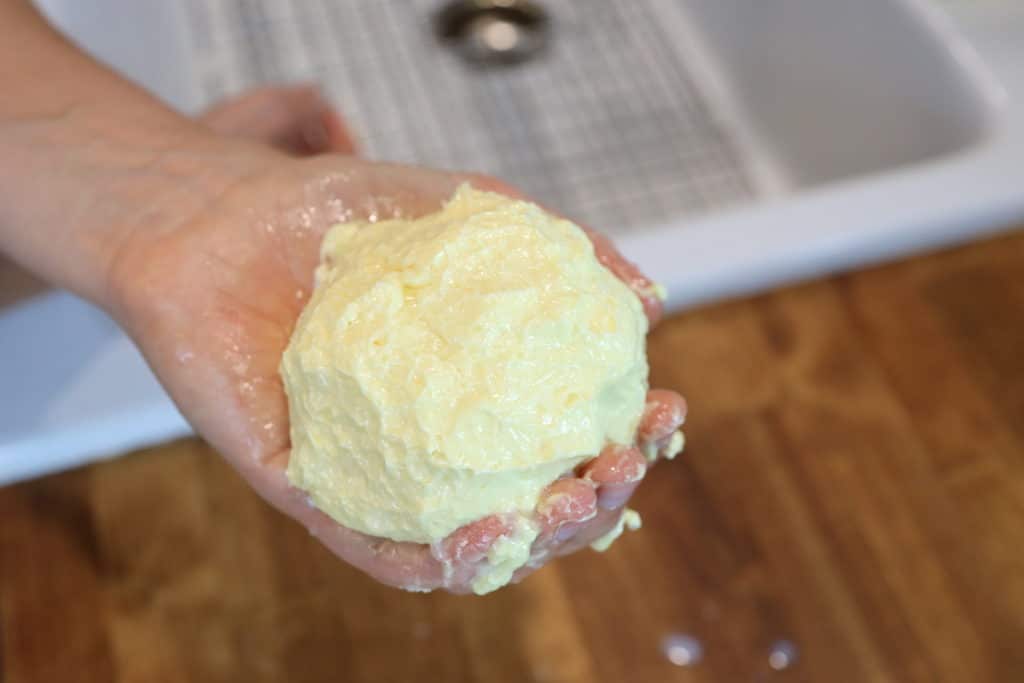
Some of the above links are affiliate links. This means we earn a small commission on qualifying purchases at no cost to you. We are so appreciative of your support!
How to Use the Remaining Buttermilk?
Definitely use the goodness that buttermilk is. I remember reading about Laura and Mary drinking down the buttermilk after Ma finished making butter, which is a great option! My favorite thing to do with buttermilk is to use it as a replacement to the 1 cup of milk when making our vanilla ice cream.
Looking for more recipes from the home dairy, check out:
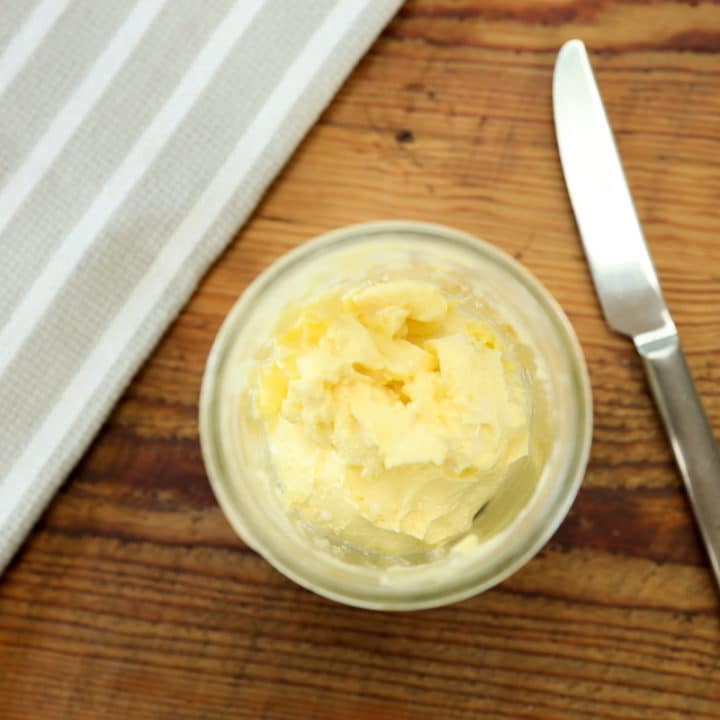
How to Make Butter from Raw Milk In a Blender
When it comes to the amazing benefits that a family milk cow provides, raw milk butter may be at the top of that list! Making butter may bring up mental images of Ma Ingalls churning her butter. But, we will show you the quick and easy way of how to make butter from raw milk in a blender.
Ingredients
- 1 Pint heavy cream (or more!)
- Salt or other herbs (optional)
Instructions
- Remove cream from fridge 2-3 hours before you want to make your butter.
- Pour cream into blender.
- Turn to a medium to high speed (6-7 on Vitamix) and watch as your cream begins to thicken to a whipped cream.
- Once a whipped cream is made, reduce speed to low to medium (2-4 on Vitamix).
- Mix on low speed until the whipped cream breaks and the butter fat has separated from buttermilk. I like to use the tamper that comes with the Vitamix to agitate the cream during this step.
- Once cream has fully separated out the fat globules from buttermilk, turn off blender.
- Pour the contents of your blender into a fine mesh strainer catching the butter in your strainer and collect your buttermilk in another container below.
- When you have all of your butter in the strainer, you want to remove as much of the remaining buttermilk as possible. Do this by cooling the butter down right away. You could submerge you butter in an ice bath but I prefer to form it into a ball and run it until cold tap water. Gently squeeze any remaining buttermilk out.
- Optional - mix in salt or herbs as desired.
- Put butter into container of choice and refrigerate until ready to use.
Pin it for later!

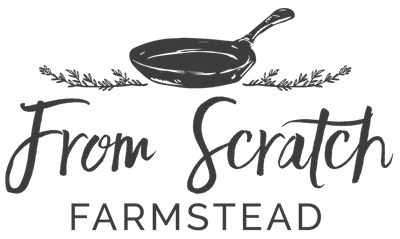

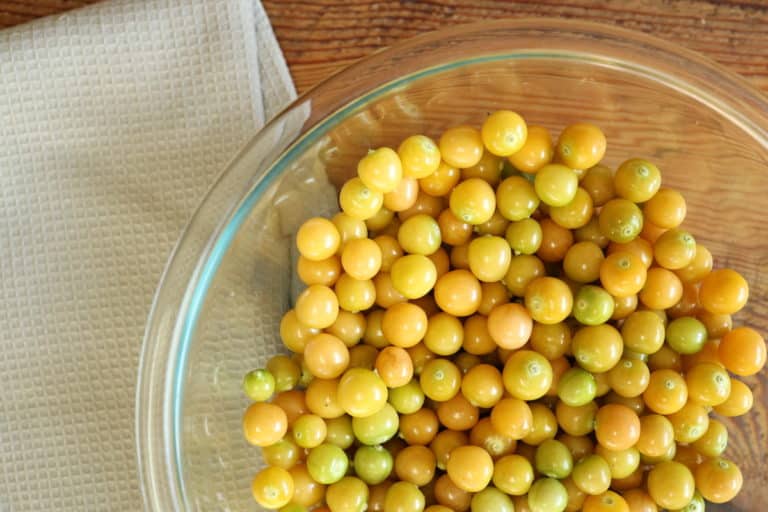
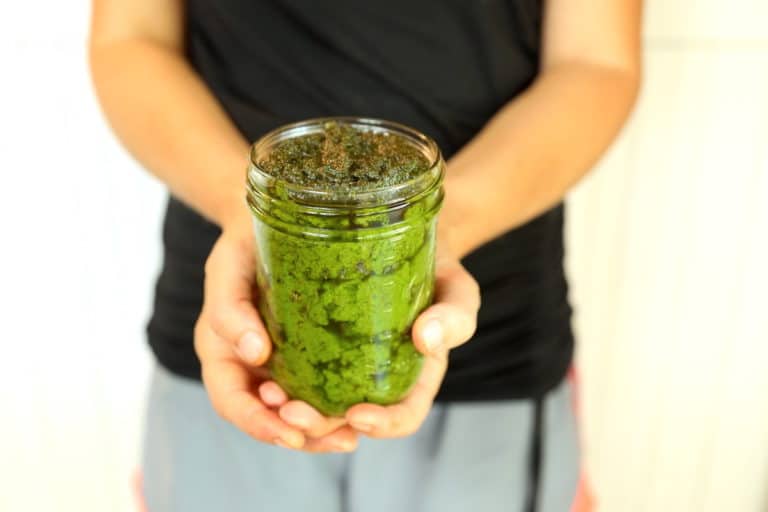
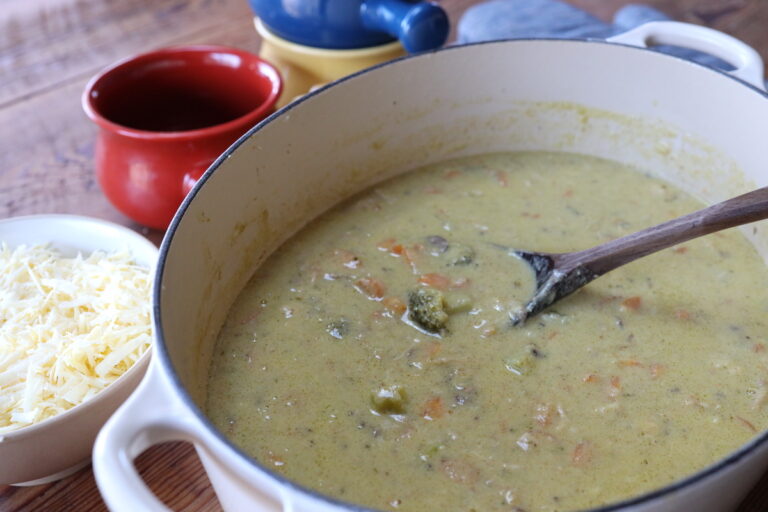
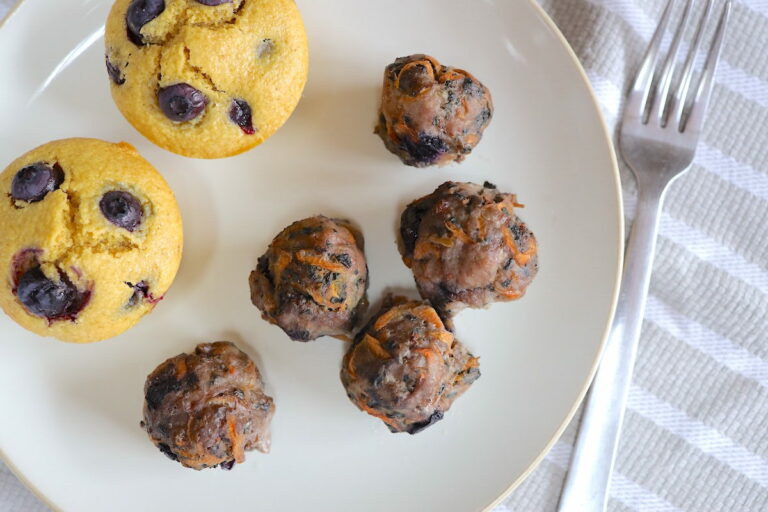
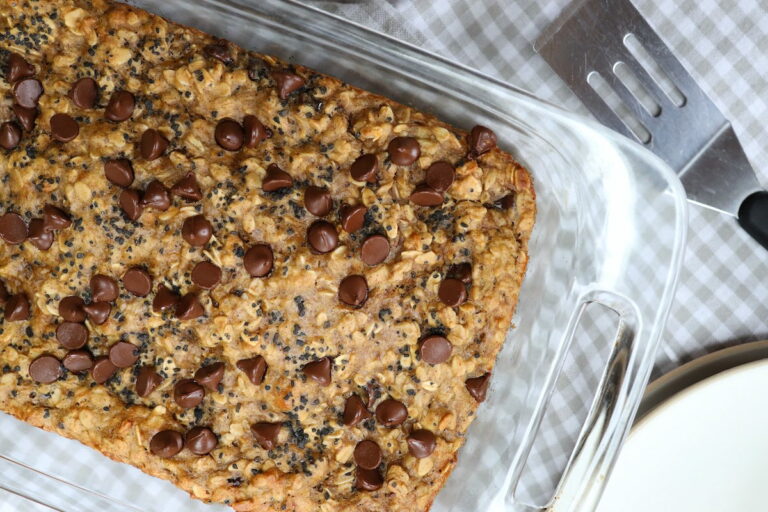
If we just have raw milk, fresh from grass fed cow. Do I need to do anything different?
Yep! That’s what we use too! Just skim the cream from the top and use that and you are good to go!
My cream wouldn’t whip after over 1/2 hour. It was a bit warm. Can I try again after I refrigerate it?
Yes, you should be able to! My go to trouble shooting things are – was your cream room temp for a couple of hours before beginning to whip it? Was it at least a few days old (not super fresh)? These two things have made the biggest difference for me in being successful with butter making. Also, cream from cows given hay in the winter generally does take considerably longer to whip into butter. In the summer when our girl is eating fresh grass, it only takes a matter of seconds to turn cream into butter but in the winter it’s often several minutes.
So I’m new to this and misunderstood the recipe I was reading. My raw milk was starting to sour so I poured it into a mason jar and let it sit out (covered) for 24 hours thinking I can make cultured butter that way. I didn’t separate the cream like I was supposed to ???? can I still naked cultured butter with this room temp raw milk? There is separation happening but it doesn’t look like cream at the top like it does in the fridge. More yellow liquid that I think it’s buttermilk? Anyway I can still do butter? If not, what can I do with this room temp raw milk so it doesn’t go to waste? I need help!
Hi! Oh no! At this point it’s more like clabbered milk or buttermilk. If you can still see the cream line and can skim the cream off the top then you can try making cultured butter. Otherwise you can definitely still use it! It would be great in any recipes calling for buttermilk, or in smoothies, etc. Hope this helps! Good luck! 🙂
How much butter do you get from 1 pint of cream? Total newbie here lol! We just got a milk cow and are enjoying all the milk, but want to learn how to make all the other stuff too!
Oh that’s very exciting! It depends on the time of year and her diet but in the summer I usually get around 1 cup of butter from 1 pint of cream. It’s less in the winter.
I have a farm down the road that sells raw milk,and i would like to start making and supporting my local farmers is there any questions i need to ask and how much should i get to start out with ? I was thinking about 5 gallons??? or should i start smaller?Any special equipment ?
That’s great! The cream and buttermilk content can vary depending on the time of year, diet, and type of cow. I usually make butter when I have a pint of cream which I usually get from skimming the cream off of 1.5 gallons – 2 gallons. Sometimes less if there’s lots of cream but it ebbs and flows. The yields of butter fat are definitely greater in the summer when the cows are eating fresh grass as opposed to hay. I hope this is helpful!
Hi there! Just wondering if the raw milk is made into butter, does it have a longer shelf life?
When butter is made with raw milk, it really doesn’t go bad but it will become cultured fairly quickly. We just see it as an extra benefit and beneficial bacteria.
Thanks for your great website! Can I use the buttermilk and make it cultured (by adding yogurt) so I can make your Cultured Cream Recipe?
That should work – especially if you are using raw cream to make your cultured cream! Enjoy!
Newbie here! How much salt would I add to the butter once I’ve rinsed it?
Hi! Good question! I never actually measure, just sprinkle it in there. Maybe a 1/2 tsp – 1 tsp? I hope your butter turned out really well!
How long will buttermilk last in your fridge and how can I preserve it?
It will start to sour after a few days to a week. It’s not “bad” if you are using raw milk but cultured. You could always freeze it.